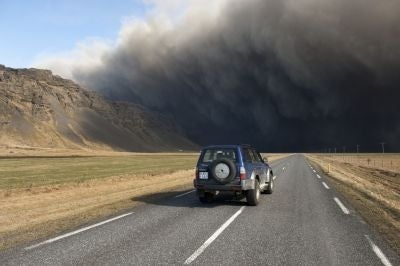Your support helps us to tell the story
From reproductive rights to climate change to Big Tech, The Independent is on the ground when the story is developing. Whether it's investigating the financials of Elon Musk's pro-Trump PAC or producing our latest documentary, 'The A Word', which shines a light on the American women fighting for reproductive rights, we know how important it is to parse out the facts from the messaging.
At such a critical moment in US history, we need reporters on the ground. Your donation allows us to keep sending journalists to speak to both sides of the story.
The Independent is trusted by Americans across the entire political spectrum. And unlike many other quality news outlets, we choose not to lock Americans out of our reporting and analysis with paywalls. We believe quality journalism should be available to everyone, paid for by those who can afford it.
Your support makes all the difference.Iceland's Eyjafjoell volcano is emitting between 150,000 and 300,000 tonnes of carbon dioxide (CO2) per day, a figure placing it in the same emissions league as a small-to-medium European economy, experts said on Monday.
Assuming the composition of gas to be the same as in an earlier eruption on an adjacent volcano, "the CO2 flux of Eyjafjoell would be 150,000 tonnes per day," Colin Macpherson, an Earth scientist at Britain's University of Durham, said in an email.
Patrick Allard of the Paris Institute for Global Physics (IPGP) gave what he described as a "top-range" estimate of 300,000 tonnes per day.
Both insisted that these were only approximate estimates.
Extrapolated over a year, the emissions would place the volcano 47th to 75th in the world table of emitters on a country-by-country basis, according to a database at the World Resources Institute (WRI), which tracks environment and sustainable development.
A 47th ranking would place it above Austria, Belarus, Portugal, Ireland, Finland, Bulgaria, Sweden, Denmark and Switzerland, according to this list, which relates to 2005.
Experts stressed that the volcano contributed just a tiny amount - less than a third of one percentage point - of global emissions of greenhouse gases.
Total emissions by six heat-trapping gases in 2005 were more than 36 thousand million tonnes (36 gigatonnes) as measured in CO2, according to the WRI index.
"It's not of any significance compared to the anthropogenic [manmade] budget," said Kjetil Toerseth, director of regional and global pollution at the Norwegian Institute for Air Research.
Specialists cautioned those who believe the eruption is good for climate change as carbon-emitting jetliners are unable to take to the skies.
According to the European Environment Agency (EAA), daily emissions from the aviation sector in the 27 nations of the European Union are around 440,000 tonnes per day.
Not all of this is saved because of the volcanic eruption, said the sources.
Firstly, some airports in southern Europe have remained open for traffic.
In addition, carbon is emitted when passengers stranded by air travel use the train, bus, car or ferry as an alternative.
And many flights in, to and from Europe are merely being deferred until the crisis is over.
"Whether the emissions occur now or three weeks from now does not change things fundamentally," said Herve Le Treut, a French climatologist.
"Another point is that these emissions are of long duration. CO2 is dangerous because it stays in the atmosphere for about a hundred years. Its short-term effect is not the big problem."

Join our commenting forum
Join thought-provoking conversations, follow other Independent readers and see their replies
Comments